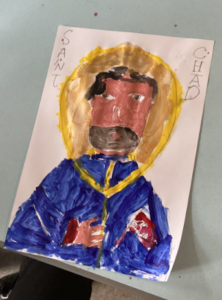Our School Saints
Each classroom has a class saint which the children pray to each day. The children ask their class saint to intercede for them each day at the end of prayers as they say “Saint (name), pray for us.”
You may want to introduce this to family prayer at home. Feel free to send in pictures, etc, of your child’s class saint to their class teacher, to be displayed on or around the RE focus.
Can you research when your child’s class saint celebrates a feast day?
Our Class Saints are:
Reception – St Vincent De Paul
Year 1 – St Chad
Year 2 – St Francis of Assisi
Year 3 – St Martin De Porres
Year 4 – St Oscar Romero
Year 5 – St Josephine Bakhita
Year 6 – St Teresa of Calcutta
Reception Class – St Vincent De Paul

St. Vincent was born in France in 1581. Despite studying law, he was called to the priesthood. As a priest he was astonished by the poverty he saw and this ignited his passion to help the poor and the marginalised. This movement to help the poor was ground-breaking then.
After his death in 1660, his virtue of charity became an inspiration for many Catholic organisations, most notably the Vincent De Paul Society, which is still very active today, helping ‘anyone experiencing poverty in England and Wales or overseas at any point before, during or after a crisis’.
St Vincent’s feast day is 27th September.
We celebrated with Mass and cakes
Year 1 – St Chad
 St Chad was a priest, a monk and eventually Bishop of Litchfield. He bought Christianity to the midlands which was then known as Mercia. He built churches and monasteries all over England. There were many schools and churches named after him in his honour.
St Chad was a priest, a monk and eventually Bishop of Litchfield. He bought Christianity to the midlands which was then known as Mercia. He built churches and monasteries all over England. There were many schools and churches named after him in his honour.
St Chad walked everywhere. He refused to ride on a horse and would travel by foot – just as Jesus did!
They wrote a song about their class saint
https://youtube.com/shorts/7-H0VY73vZI?si=naZrz6wfE8w0LCZO


Year 2 – St Francis of Assisi

St Francis was born in Assisi, Italy in 1182. He grew up leading a privileged life as the son of a wealthy cloth merchant. As a boy, Francis loved to learn and sing songs. His father wanted him to become a businessman and taught him about the French culture. In 1202, Francis took part in a war, was taken prisoner and held for almost a year. Three years later, Francis planned to fight in another conflict but on his way there, he had a vision. In the vision, he was told to return to Assisi and wait for a call to a new kind of knighthood. He returned to Assisi and spent time alone praying.
Over the next few years, Francis had experiences that inspired him to give up all his possessions and to live in poverty. Francis began to preach and attracted followers or disciples. In 1209, he declared a simple rule for his disciples: to follow Jesus Christ and to act as Christ did.
Francis was known for his love of nature and animals.
Francis died in Assisi on 3rd October in 1226. He was canonized on 16th July, 1228.
We celebrate his feast day on the 4th October. We made badges and told everyone all about St Francis.
Year 3 – St Martin De Porres
Saint Martin de Porres is the patron saint of racial harmony and social justice.
Saint Martin faced great hardship in his childhood and was often mistreated due to the colour of his skin. As Martin grew he worked alongside a doctor to learn medicine. He spent hours of the night in prayer, a practice which increased as he grew older.
Under Peruvian law, descendants of Africans and Native Americans were barred from becoming full members of religious orders. The only route open to Martin was to clean and cook for the Brothers of the monastery. In return, he would be privileged to wear a habit and live within the religious community.
Martin continued to practice his old trades of barbering and healing and was said to have performed many miraculous cures. He also took on kitchen work, laundry, and cleaning. After eight years at Holy Rosary, he was finally accepted as a Dominican brother.
We celebrate his feast day on November 3rd and we remember him for his dedication to God and his power to perform miracles of healing.
Year 4 – St Oscar Romero

Oscar Romero’s feast day is 24th March.
Oscar Romero was the archbishop of San Salvador, Central America, from 1977- 1980. He is one of the most remarkable figures of the 20th century. He was a peacemaker who sacrificed his own life standing up to injustices. He was a leader who had courage, faith and love to stand up for the poor.
During his three years as Archbishop of San Salvador he denounced violence and spoke out in support of the victims of the war. He defended the rights of the poor to demand political change.
He reminds us that Christ is found in people living in poverty, and we cannot ignore the suffering of our brothers and sisters in need.
Year 5 – St Josephine Bakhita

St Josephine Bakhita, who was sold to slavery at a young age, is known as the patron saint of victims of modern slavery and human trafficking. Her Feast Day is on February 8, also known as the World Day of Prayer, Reflection and Action Against Human Trafficking.
St Josephine experienced such trauma during her kidnapping that she forgot her own birth name. Her kidnappers named her ‘Bakhita’ meaning ‘fortunate’.
An Italian official was her key to freedom. Callisto Legnani eventually purchased Bakhita and she was pleasantly surprised when the cruel treatment of her was over. In Legnani’s residence, she experienced kindness, joy and love.
St Josephine Bakhita is an inspiring role model of forgiveness.
Year 6 – St. Teresa of Calcutta





 St Chad wa
St Chad wa
